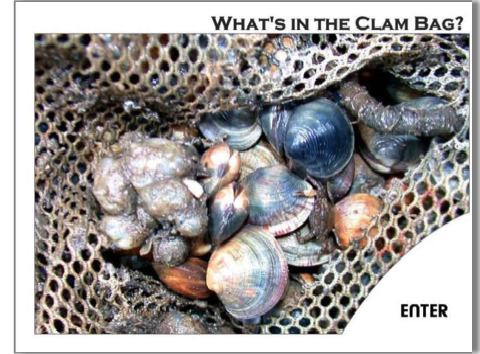Environmental Benefits
Clam Culture is GOOD for the Environment.
Clams provide a favorable environment for the coastal waters in which they are grown. In turn, coastal communities can benefit from the variety of ecosystem services that are generated as a byproduct of clam farming.
The unique sustainability of Florida clam culture was demonstrated in a recent University of Florida (UF) study. Three environmentally-beneficial ecosystem services (water filtration, nitrogen removal and carbon storage) provided by clam farming were examined. Efforts focused on assembling ecosystem service values specific to clam culture.
Measurements, particularly for harvest-sized clams at water temperatures found in Florida, are not available through the literature. To address these information gaps, pertinent laboratory measures were determined. Read further for a description of these ecosystem services, their value estimates, and how they relate to Florida’s “green” clam culture industry.
What are Ecosystem Services? The transformation of a set of natural resources supplied by ecosystems into beneficial goods and functions that humans value. An ecosystem is a complex system of plant, animal, fungal, and microorganism communities and their associated non-living environment interacting as an ecological unit.
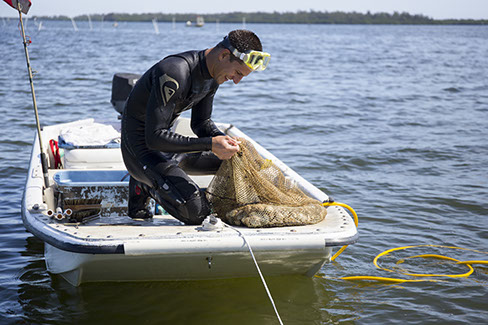
Clams Clean the Water by Filter Feeding
A single littleneck-sized clam can filter 4.5 gallons of seawater per day.
By the very act of feeding, clams filter phytoplankton (microscopic algae or plants) out of the water, cleaning and clarifying the water. In doing so, they improve water quality by reducing sediment loads and turbidity of coastal waters and remove excess nutrients from the water. Clearer water allows more sunlight to penetrate, which aids in the growth of important seagrasses and increases oxygen in the coastal environment. By removing phytoplankton and nutrients from the water, clams may also prevent harmful algal blooms.
In this time lapse video, the clam’s water-cleaning efficiency is demonstrated by placing 24 littlenecks in a 2.5 gallon aquarium containing algae (density of 396,000 cells/ml). Compare what happens, over 100 minutes, in the aquarium with clams (right) and the aquarium without clams (left).
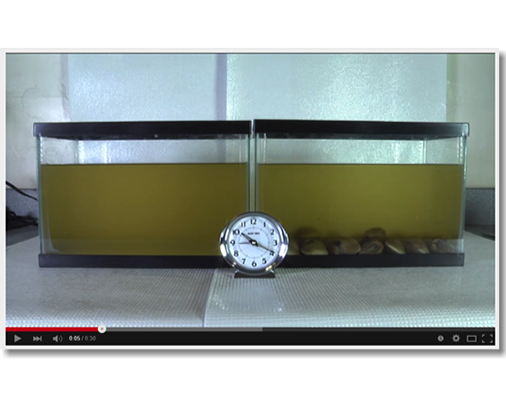
Clams Remove Nitrogen from Coastal Waters
A single littleneck-sized clam can remove 0.09 grams of nitrogen from the water.
Clams play an important role in the cycling of nutrients, including nitrogen. Clams do not absorb nitrogen directly from their environment, rather they feed on naturally-occurring phytoplankton, which use dissolved inorganic nitrogen, available in the water, to grow. Thus, clams incorporate nitrogen from their food into their tissues and shells. When clams are harvested, the accumulated nitrogen is removed from the water.
Clams also play an important role in the cycling of nutrients, including nitrogen. For example, clams release nitrogenous waste (urine) that can be used by phytoplankton as a source of nitrogen. In addition, some of the nitrogen filtered from the water by the clam is deposited to the sediment as feces and pseudofeces (rejected food particles). These biodeposits are decomposed by bacteria, which transform the nitrogen to a variety of other forms, including ammonium, nitrate, and nitrogen gas.
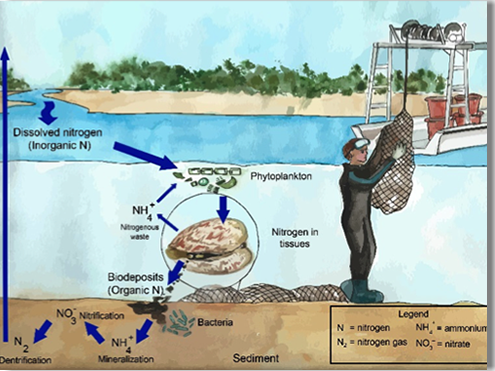
The role of clams in the cycling and removal of nitrogen from the marine environment.
Clams Sequester Carbon from the Atmosphere
A single littleneck-sized clam can store 2.76 grams of carbon.
Clams convert carbon into calcium carbonate shell. The carbonate used by clams is primarily derived from atmospheric carbon dioxide dissolved in seawater. Thereby, the shells of clams provide a long-term carbon sink. Clams not only store carbon in their shells and tissues, but also process it while they are growing.
Just like other animals, they produce carbon dioxide as a waste product of respiration. In addition, the carbon (particulate organic carbon) deposited in the sediments as feces and pseudofeces is consumed by a variety of organisms, such as worms, brittle stars, and other deposit feeders.
Some carbon will remain locked in the sediments and can persist indefinitely as shell fragments, limestone, and dolomite. In contrast, the carbon contained in most plant and animal tissues returns to carbon dioxide within a few years.

The role of clams in sequestering atmospheric carbon.
Clam Culture Stimulates Diversity
Over 150 marine plants and animals can be found on a clam farm.
The culture gear (bags, cover netting) used by growers creates a favorable environment for a myriad of plants and animals, such as juvenile fish and crabs, by providing habitat, substrate, and protection. This is especially significant since clam farms can only be located in areas that undergo a resource survey to ensure the site is devoid of seagrasses and other marine life.
Once in production, a clam farm may have over 1000 bags planted per acre of lease bottom. The diversity and abundance of marine organisms stimulated through farming activities is one of many positive benefits that shellfish aquaculture provides to the coastal environment.
A pictorial guide of over 150 marine organisms commonly found in, on, and around clam culture bags on farms in the Big Bend area of Florida features over 150 plants and animals organisms and assists clam farmers in identifying them.
Value of Environmental Benefits provided by Florida Clam Production
The contribution of the Florida clam culture industry to the mitigation of nitrogen and carbon extraction was assessed by UF economists through calculation of costs that would be incurred to replace the industry’s services with the next best alternative. For nitrogen removal, replacement cost values were based on the costs of wastewater treatment plants in various Florida cities. Values ranged from $3.44 to $5.22 per pound of nitrogen removed, based on county land values and cost of living, factors that affect the cost of wastewater treatment plants.
For carbon sequestration, the creation and maintenance of pine tree plantations was used as a possible alternative to clam production. Costs included pine production, as well as the value of the land in an alternative use; in counties with high agricultural, commercial, or urban land values, this opportunity cost of utilizing the land as a pine plantation was high. Values ranged from $119 per ton for Collier County, while the lowest ($0.71 per ton) costs were found in Franklin County, primarily due to lower land values in the more rural county.
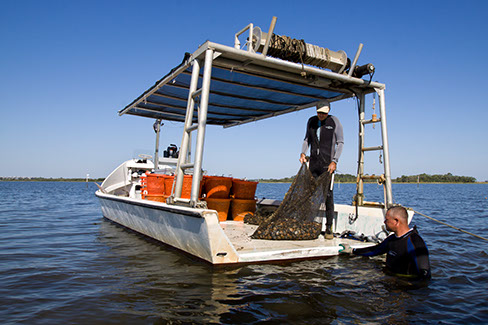
Highlights of the UF study on environmentally-beneficial ecosystem services and their value provided by Florida clam production (statistics obtained from the 2012 Florida Aquaculture Survey conducted by the USDA) include:
• Due to clams’ filtration capacity, 544 million gallons of seawater were filtered by the statewide production of 136 million clams.
• Through the harvest of 136 million clams, over 25 thousand pounds of nitrogen were removed and 760 thousand pounds of carbon were stored from the coastal environment.
• The economic value of these environmental benefits was estimated at $99,680, which represents the public good value that the industry generates to Florida citizens at no cost.
Results demonstrate the important contribution of hard clam culture to coastal ecosystem services. These findings on clam farm sustainability benefit growers, wholesalers, and retailers by allowing them to inform buyers and consumers that shellfish aquaculture is green and, in fact, provide ecosystem services. Consumers benefit by being made aware of the environmental benefits of sustainable shellfish aquaculture.
Florida Clam Culture is Sustainable
In addition to being good for the environment, clam aquaculture is sustainable marine farming at its best. Clam farming has proven to be sustainable because it does not damage the environment or jeopardize future productivity. Annual harvests are made possible by replanting hatchery-produced seed. Clams naturally feed low on the food chain and don’t require supplemental feed. Further, no inputs of fertilizers, drugs, antibiotics, or chemicals are used in their production.
For these reasons, cultured clams have gotten a “thumbs up” from various environmental groups, such as the Environmental Defense Fund, the Chefs Collaborative’s Seafood Solutions, and others. Farmed clams are recommended as a “Best Choice” by the Monterey Bay Aquarium’s Seafood Watch program. These groups work to steer consumers towards sustainably produced seafoods.
For more information about the environmental benefits of shellfish aquaculture, visit the East Coast Shellfish Growers Association’s website or download their informative brochure here.

